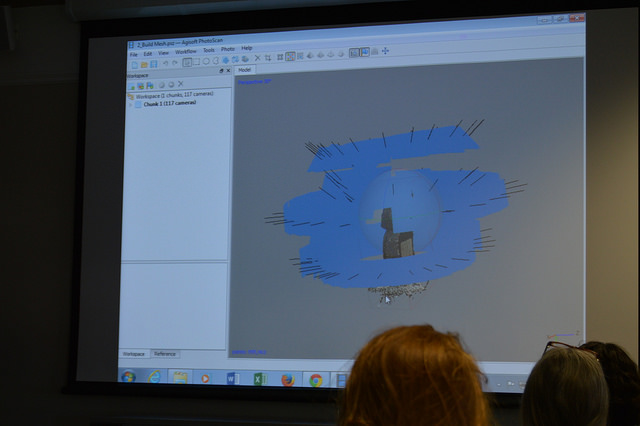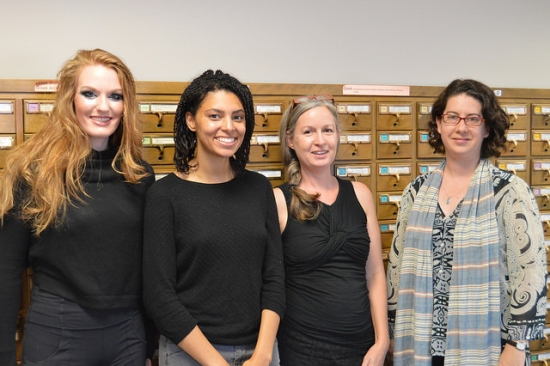On August 24th, the Visual Resources Center (VRC) hosted a workshop and several presentations on photogrammetric and 3D modeling tools and techniques. DH Fellow Lisa Trever, Assistant Professor in History of Art, presented her ongoing work on excavated murals at Pañamarca, Peru. This summer, she was joined by DH Interns Isabella Warren, a M.Arch student at the College of Environmental Design and Ashley Jerbic, a senior undergraduate in History of Art and Art Practice. Ashley and Isabella also led a short workshop and demo on tools such as Rhino 3D, Photoscan, and Sketchup. Lynn Cunningham, Principal Digital Curator at the VRC, shared notable projects from the NEH Summer Institute, “Advanced Challenges in Theory and Practice in 3D Modeling of Cultural Heritage Sites.”
Restoring Context with New Technologies
Bringing her background as an archaeologist to her work, Lisa explained that the “text” of the murals must be read in two aspects. Both the content of a mural and the context of the site in which it appears frame the analysis of these works. At Pañamarca, ongoing excavation since the 1950s, structure collapse, looters, and erosion have all contributed to the deterioration of the murals, obscuring the context of these works.
Using photogrammetric and 3D modeling techniques, Isabella and Ashley worked to bring new context to these works, expanding from site drawings and photographs. Using Photoshop, Ashley combined archaeologists’ 1950 site drawings and photos of the deteriorated murals taken by Trever in 2010. 
Photogrammetry played a key role in Isabella’s work on the project. Photogrammetric techniques utilize many photos of an object, captured from a variety of angles. Photogrammetric software, such as Agisoft Photoscan, analyze the changing angles of the photos to make a 3D model of the object. In the photo (right), Isabella visualizes the angles of capture for a small figurine. Working with Ashley’s combination of drawings and photographs, Isabella created a model that represented the mural as a work spread around a room, painted on rough and uneven walls.
Isabella was also able to work with 600 drone photos of the entire Pañamarca site taken by another archaeologist at the site. Using Agisoft once again, Isabella created a model of the larger excavation site. In Rhinoceros (commonly known as Rhino 3D), Isabella combined the two models, placing the mural in the larger context of Pañamarca. Trever hopes that future work will draw upon the many murals found at Pañamarca, illuminating murals’ relationship to one another.
After their presentation, Ashley and Isabella demoed some of the tools they use in their workflow. Ashley demonstrated a model of Mission San Gabriel, created in Sketchup, which supported her senior thesis work. Utilizing 3ds Max, she analyzed various seasonal lighting patterns within the model. Examine Isabella's model of a small figurine, created in Photoscan, at Sketchfab.
What We Can and Can’t Model
Fresh from the NEH Summer Institute, “Advanced Challenges in Theory and Practice in 3D Modeling of Cultural Heritage Sites”, Lynn provided case studies of several projects in modeling cultural heritage sites, such as the 1893 World's Columbian Exposition and the Parthenon. While these models cannot capture all aspects of a site that may interest art historians (such as details in a Corinthian column), Lynn argued that models could help art historians understand scale and the experience of moving through a space. Used in conjunction with site photographs and drawings, these models further enrich scholars’ work. Lynn noted that models can be extremely detailed, depending on the amount of time and resources available to a project, but the type of model will ultimately be determined by the research question.
Undergraduate Seminar
This fall, undergraduate students in Lisa’s “Mural Painting and the Ancient Americas” seminar will have the opportunity to begin digging into 3D modeling and photogrammetric methods. Students will document and model several murals around the Bay Area. With the guidance of staff at the Archaeological Research Facility and the VRC, students will begin practicing their skills with site photos from Pañamarca.
See more photos from the event on DH at Berkeley’s Flickr account.
